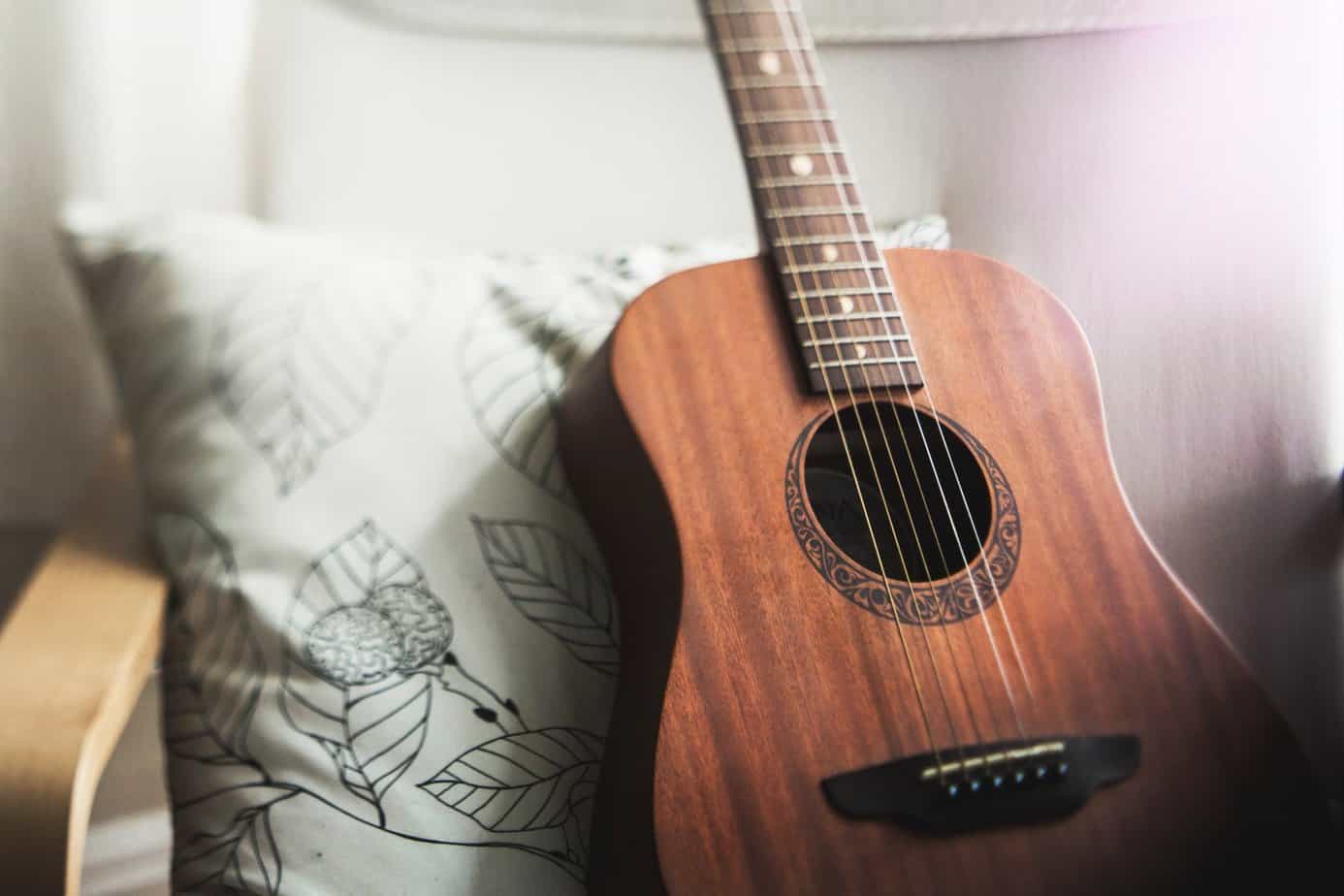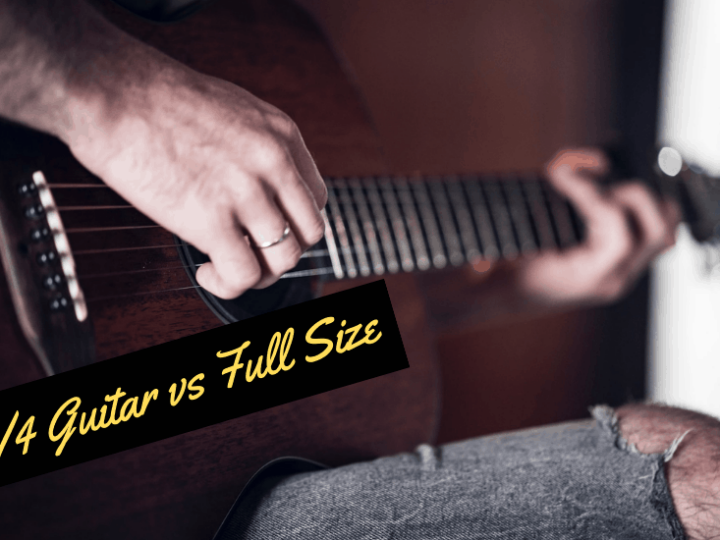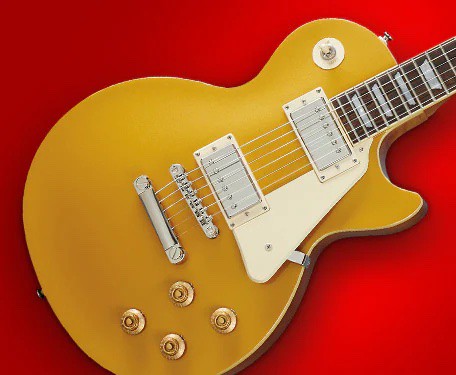Feeling comfortable with the instrument you are playing is one of the key factors that enable you to grow as a musician.
Every guitar player has at one point faced a choice between ¾ guitar vs full size as either guitar type can be useful during different stages of the guitar learning process.
One of the first things you will notice when you start searching for a new guitar is that they vary in size. Even a ukulele can be considered a guitar which goes to show you just how wide the selection of guitar sizes really is.
Although a ¾ guitar is significantly larger than a ukulele it is still small enough so that children or grown-ups that don’t have long fingers can play them without struggling to reach low notes.
Our ¾ guitar vs full size comparison is going to take a closer look at how these guitar types differ and help you determine which one is the better choice for you.
The Main Differences between ¾ Guitar vs Full Size Guitar
The main differences between a full size and ¾ guitars are:
- ¾ guitar has the dimensions of 36 x 13 inches, whereas the dimensions of a full size guitar around 40 x15 inches.
- Full size guitar has a scale length that is longer than 24 inches, whereas the scale length on 1 a ¾ guitar is between 20 and 24 inches
- ¾ guitars don’t have a high string tension, whereas a full size guitar maintains string tension which keeps the instrument in tune
- Full size guitars can cost thousands of dollars, whereas a ¾ guitar can be purchased for less than a hundred dollars
- Full size guitar produces a rich characteristic tone, whereas ¾ guitars often don’t have the capacity to replicate that sound
Featuring quality laminate construction with a modern Fender 3+3 headstock, the FA-15 not only sounds great, but is also easy to pick up even for beginning guitarists. With a nato neck for a lively tone, the Fender FA-15 comes with a gig bag for portable protection.
Although the same string sets can be used on full size acoustic guitars and ¾ guitars, manufacturers like D’Addario offer string sets such as EJ27N that are designed specifically for ¾ guitars.
D'Addario's premier entry level 1/2 size classical string set, known for its optimal balance of warmth and projection. Features: Normal tension, Clear Nylon, Non-Ball End.
Despite all the differences, full size and ¾ guitars have a lot in common, including their components, shape, number of strings, or the tuning process.
Key Specification Differences Between a Full Size vs 3/4 Size Acoustic
| ¾ guitar | Full size guitar | |
| Body shape | ¾ classical | Classical |
| Body material | Mahogany depends on the model | Mahogany depends on the model |
| Overall size | 36 x 13 inches | 40 x 15 inches |
| Scale length | 24 inches or less | 24 inches or more |
| Frets | 18 or less | 19 or more |
| Warranty | Depends on the manufacturer | Depends on the manufacturer |
| Check the latest price | Check the latest price here | Check the latest price here |
An overview of the features ¾ vs Full Size guitars offer
So let’s take a closer look at the features ¾ guitars and full-size guitars offer.
¾ Guitars
Learning to read guitar chords is just the first step towards knowing how to play them. A ¾ guitar is a great choice for the first guitar, as its size makes finger exercises easier, as you don’t have to cover too much space.
A ¾ guitar is particularly a good choice for children between 8 and 12 years old who are just starting to learn how to play the guitar because it is better adjusted to their height.
However, adults can also find playing a ¾ guitar comfortable, especially if they have trouble reaching lower tones or upper frets on standard size guitars.
It is also important to understand that ¾ guitar has the same parts like a full size guitar, and getting a smaller sized guitar won’t affect the guitar playing experience.
Key features
- Most ¾ guitar models have a mahogany body
- The scale length varies from 20 to 24 inches
- There are 18 or fewer frets on the neck
- Necks can be made of okume, rosewood, or maple
- All ¾ guitars have a headstock that houses tuning pegs
- You can use regular 4/4 and 3/4 guitar nylon string sets
- ¾ guitars are commonly used as practice guitars
Shape and size
The actual size of a ¾ guitar varies from one model to another, but as a general rule of thumb, their length doesn’t exceed 36 inches. The width of a ¾ guitar is usually around 13 inches but and if a guitar’s body is wider than that, it means that it isn’t a ¾ guitar.
There are almost no differences in terms of how the bodies of ¾ guitars and full size guitars look, so unless you compare their sizes you will have a tough time differentiating between them.
Due to the smaller overall size, the scale length on a ¾ guitar is shorter, and it doesn’t exceed 24 inches. Consequently, there is less tension in the strings, and is easier to press a string or bend it.
It is worth noting that the scale length affects both playability and tone so a ¾ guitar is not going to sound as good as a full size guitar, although it is easier to play it.
Featuring quality laminate construction with a modern Fender 3+3 headstock, the FA-15 not only sounds great, but is also easy to pick up even for beginning guitarists. With a nato neck for a lively tone, the Fender FA-15 comes with a gig bag for portable protection.
Sound
The low string tension has one major downside. ¾ guitars tend to go out of tune quicker than full size guitars because their strings are a bit loose.
As a result, novice players can bend a string even if they weren’t planning on doing that which can change the way a power chord or any other chord sounds. So even though they are not hard on fingertips, you may have to tune a ¾ guitars as frequently as once per hour.
These guitars should be regarded as practice guitars primarily, as their sound is usually not good enough for live performances.
Besides, your choice of guitar strings will affect the instrument’s sound, so you should try out several different gauges before settling for the set that produces the best sound.
Even so, a ¾ guitar can be used to play any genre of music from classical to pop which makes it a great fit for informal jam sessions or novice players who are still learning how to use this instrument.

Other noteworthy features
The body, neck, and all other parts of a ¾ guitar are not different from those you can find on a full size guitar. Hence, it will be easier to choose a ¾ guitar if you already know which of its parts can improve its playability.
The tuning mechanism is arguably one of the most important features you should consider, as you will be using it frequently. You should also consider getting accessories such as a capo, a tuner, or guitar picks.
Also, keep in mind that ¾ guitars are not durable, and without proper maintenance, they may decay quickly.
Reliability
All major guitar brands offer acoustic and electric ¾ guitars, so you can choose from manufacturers such as Ibanez, Gibson, or Fender.
Each of these brands has a long tradition of producing guitars at the highest standards, and you can hardly go wrong if you opt for either of them. A ¾ guitar manufactured by one of the industry-leading brands shouldn’t be less reliable than a full-size guitar.
How long a ¾ guitar model is going to last depends on how often you use it and how well you take care of it. Also, you shouldn’t overspend on a ¾ guitar if you are just starting out, because you can transition to a full-size guitar as you get better.
Full Size Guitars
What is the standard size of a guitar, is a heavily debated question that doesn’t have a definitive answer. The sizes of the so-called 4/4 guitars depend on their manufacturer, but most models are around 40 inches long.
The exception are headless guitars, as these electric guitars have a built-in tuner rather than a headstock that holds tuning pegs. As a result, they are shorter than other full size guitars, but this doesn’t have an impact on their sound or playability.

Choosing a full size guitar based solely on its size is difficult, as there are countless other aspects you have to consider. So, let’s take a look at the features that are going to help you choose a 4/4 guitar that fits your height and playing style.
Key features
- Available with single, double, or non-cutaway bodies
- Most models have dimensions of 40 x 15 inches
- The scale length is longer than 24 inches
- The neck has more than 19 frets
- The materials used to build the neck and the body depend on the model and manufacturer
- Compatibility with string gauges depends on the guitar
- Prices of full size guitars range from a few hundred to several thousand dollars
Shape and size
A classical instrument like the Yamaha C40 is around 40 inches long and 15 inches wide, which makes it suitable for players taller than 5 feet.
Also, this classical full size guitar has a 25.59-inch scale which ensures a better string tension. 4/4 classical and acoustic guitars don’t look different than their ¾ counterparts, as their bodies may or may not have cutaways.
Necks of these guitars have more frets which allows for greater tonal versatility, although the larger size and width of the neck can make reaching low notes more difficult for players who don’t have long fingers.
Even though these guitars produce the sound that is characteristic for all classical and acoustic guitars, their sound properties depend on the model as the material from which a full size guitar is made affects its sound.
Full size guitars are compatible with both nylon and steel guitar strings that have different gauges, and you must select a guitar string set that fits your instrument.
Spruce Top, Nato Neck, with Indonesian Mahogany Back and Sides. Beginners and young learners alike will appreciate the quality found in this Yamaha C series classical guitar.
Sound
Full size guitars are less likely to go out of tune quickly than ¾ guitars because they maintain string tension. Even so, you still have to tune them regularly if you want to make the most of their sound capabilities.
Ultimately, the sound of a full size guitar depends on its type, since an electric and acoustic 4/4 guitar sound completely different. Manufacturers like Yamaha or Fender are famous for producing instruments used at concerts or in a studio.
The 800 Series features a new scalloped bracing pattern; an ideal acoustic structure that maintains the durability of the top board, while bringing out more of the natural sound of the instrument.
Compact and comfortable, the CC-60S is ideal for beginning players. The smaller concert-sized body is easy to maneuver in any playing position, with an articulate voice that's great for fingerpicking. Its tuneful solid spruce top, easy-to-play neck, and mahogany back and sides make the CC-60S a perfect choice for the beach, the patio or the coffeehouse.
In addition, full size guitars that are compatible with nylon strings tend to sound different than those that utilize steel strings. The scale length also contributes to the sound of full size guitars, but this is just one of the factors that determine the instrument’s tonal properties.
Materials from which the guitar’s body’s top, back, and sides are made are also a factor that impacts the instrument’s sound.
Other noteworthy features
Components like the bridge, tuning mechanism, or truss rod are among the features you have to pay attention to while choosing a full size guitar.
A model like the Yamaha C40 may be a good choice for players who want to transition from a ¾ guitar to a 4/4 guitar.
Full size electric guitars allow for a greater sound versatility, but you will need an amp in order to use them. You can play any genre of music with 4/4 guitars, although features other than the size determine how good your instrument is going to sound.

Reliability
How reliable your full size guitar is going to be, depends on the manufacturer. Affordable full size guitars are often built from materials that cannot withstand heavy usage, but it is highly unlikely that their key components are going to break down after a year or two.
Most guitars can last for years without ever breaking down, and keeping them in good condition or protecting them from physical damage can only extend their life span.
¾ Guitar vs Full Size – Pros and cons
¾ Guitar Pros
- Low string tension makes it easier to press them
- Excellent for practice purposes or playing while you’re on the road
- Produced by some of the industry-leading guitar manufacturers
- Affordable
¾ Guitar Cons
- ¾ guitars go out of tune quickly
- Short scale length affects the instrument’s tonal properties
Full Size Guitar Pros
- Rich and versatile sound
- High string tension reduces the need for tuning
- Great for both practices and performances
- Built from high-quality materials
Full Size Guitar Cons
- Full size guitars can be expensive
- A 4/4 guitar may be too large for children younger than 12 years of age
The best alternatives to ¾ and full size guitars
Full size and ¾ guitars are not the only guitar size you have at your disposal. Even a ¾ guitar can be too large for a child that wants to learn how to play this instrument.
Here are some of the guitar sizes that can be more appropriate for children, teenagers or adults.
Half-size guitar
The so-called halfie is around 20 inches long and 8 inches wide, which means that it is half the size of a 4/4 guitar. Half-size versions of acoustic and electric guitars are produced by almost all major guitar brands, and it shouldn’t be too difficult to find a ½ model.
These guitars are an excellent choice if you want your children to pick up guitar playing early on, but as they grow half-size guitar is going to become too small for them.
That’s why you shouldn’t overspend on these instruments, as it is unlikely that a child can use them for more than a few years. Most halfies are equipped with a tuning mechanism, which enables the child to learn how to tune a guitar early on.

¼ guitar
This is the smallest size of a guitar you can get, as these instruments usually have dimensions of 28 x 10 inches. A ¼ guitar size is only suitable for children younger than five years old, and you can choose between electric and acoustic models.
Despite being the smallest size of a guitar, the ¼ inch guitars are still large enough to support using conventional cords. A child can use these guitars to learn the basic guitar techniques, but transitioning to larger guitars is necessary to fully develop guitar playing skills.
¼ guitars sound like ukuleles, as they create a lot of treble, despite being somewhat larger than the ukulele.
Discover unbeatable prices and high-quality instruments that will inspire your creativity and take your playing to new heights. Don't miss out on the opportunity to find your dream guitar at an incredible value on Sweetwater's DealZone today.
The parlor guitar
A jump from a ¾ guitar to a dreadnought guitar can be sudden, so if you are looking for a way to gradually increase the size of a guitar you’re playing, a parlor guitar may the right solution for you.
Although they are classified as 4/4 guitars, parlor guitars are not as bulky and heavy as jumbo or dreadnought guitars. Their sound favors mid-range tones over basses, but your choice of string gauges leaves plenty of room to fine-tune the highs and lows of these guitars.
Necks of parlor guitars usually have 18 frets which make the transition from a ¾ guitar even easier.

Frequently asked questions about ¾ and full size guitars
Question: Are 3/4 guitars expensive?
Answer: How much a 3/4 guitar is going to cost depends on the model you are interested in. Some 3/4 guitars can cost around a hundred dollars, but you can end up spending much more on a high-end model.
Question: Can I use 3/4 guitars for live performances?
Answer: It doesn’t matter which type of guitar you are playing, what matters is how well you play it. 3/4 guitars can be used during live performances despite the fact that they are designed primarily as practice guitars.
Question: When is the right time to switch to a full-size guitar?
Answer: Full-size guitars are recommended for teenage and older players, but there is no age limit that prevents a player from using smaller guitar sizes.
Question: Should I choose an acoustic or electric full size guitar?
Answer: The answer to this question depends on the genre of music you want to play. In general, mastering an acoustic guitar before picking up an electric one will give you some time to polish your guitar playing skills.
The verdict: Are ¾ guitars better than full size guitars
The player’s height is probably one of the best ways to determine which size of a guitar is the best option. If the person who will be playing the guitar is shorter than 5 feet, then a ¾ guitar will be easier to handle.
On the other hand, players taller than 5 feet usually find playing a full size guitar much more comfortable. Even so, nothing is preventing you from getting a ¾ guitar if you enjoy playing it.
Featuring quality laminate construction with a modern Fender 3+3 headstock, the FA-15 not only sounds great, but is also easy to pick up even for beginning guitarists. With a nato neck for a lively tone, the Fender FA-15 comes with a gig bag for portable protection.
Hopefully, our ¾ guitar vs full size comparison has helped you decide which guitar size is a good fit for you. Leave a comment and let us know which guitar size you are going to choose or learn more about the differences between classical and acoustic guitars.
Embrace the opportunity to discover your musical talents with Guitar Center's exceptional Daily Pick, designed to unleash your inner musician. With the finest offer of the day, you can indulge in a world of musical possibilities and take your skills to new heights.
- The Yamaha FG800 vs FG830: Which to Pick? - August 23, 2023
- Best Martin Guitar Options: How to Pick the Right One - August 22, 2023
- Best Gypsy Jazz Guitars: How to Pick the Right One? - August 22, 2023









